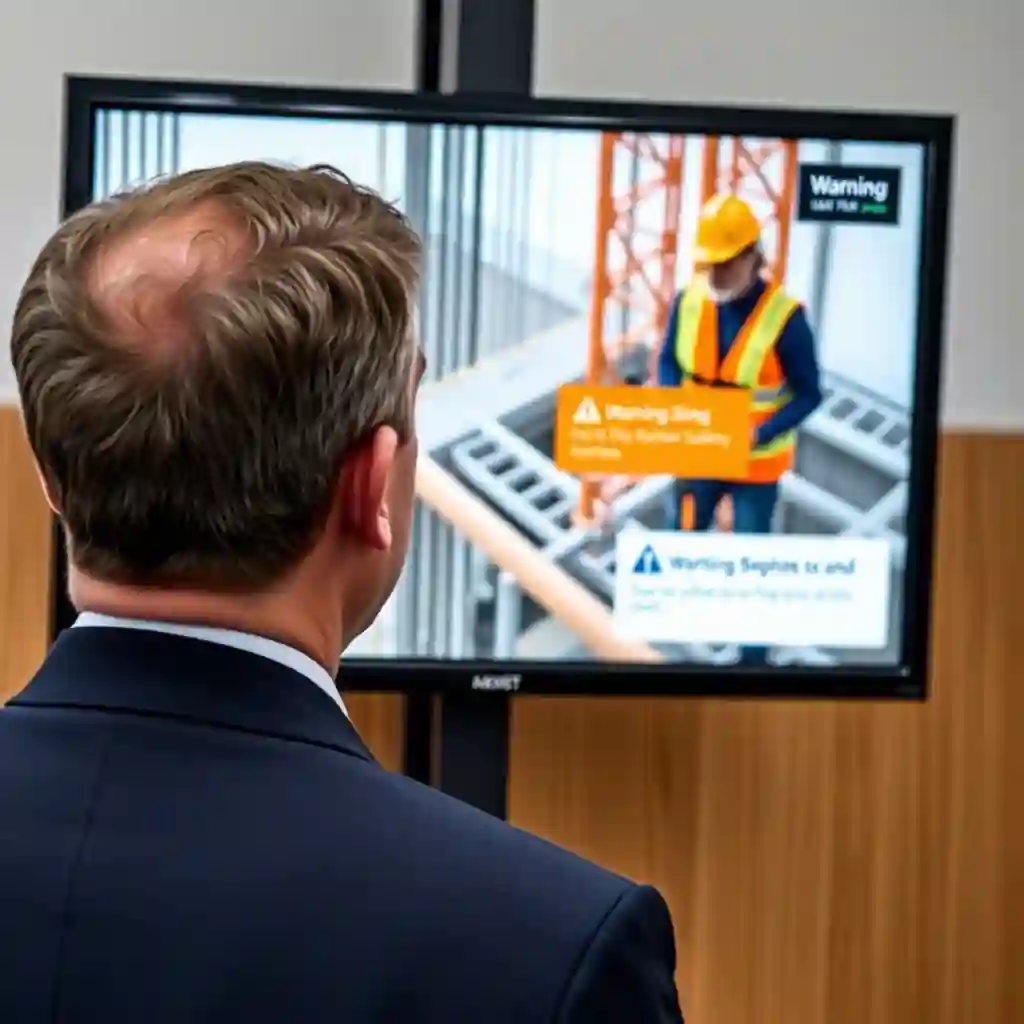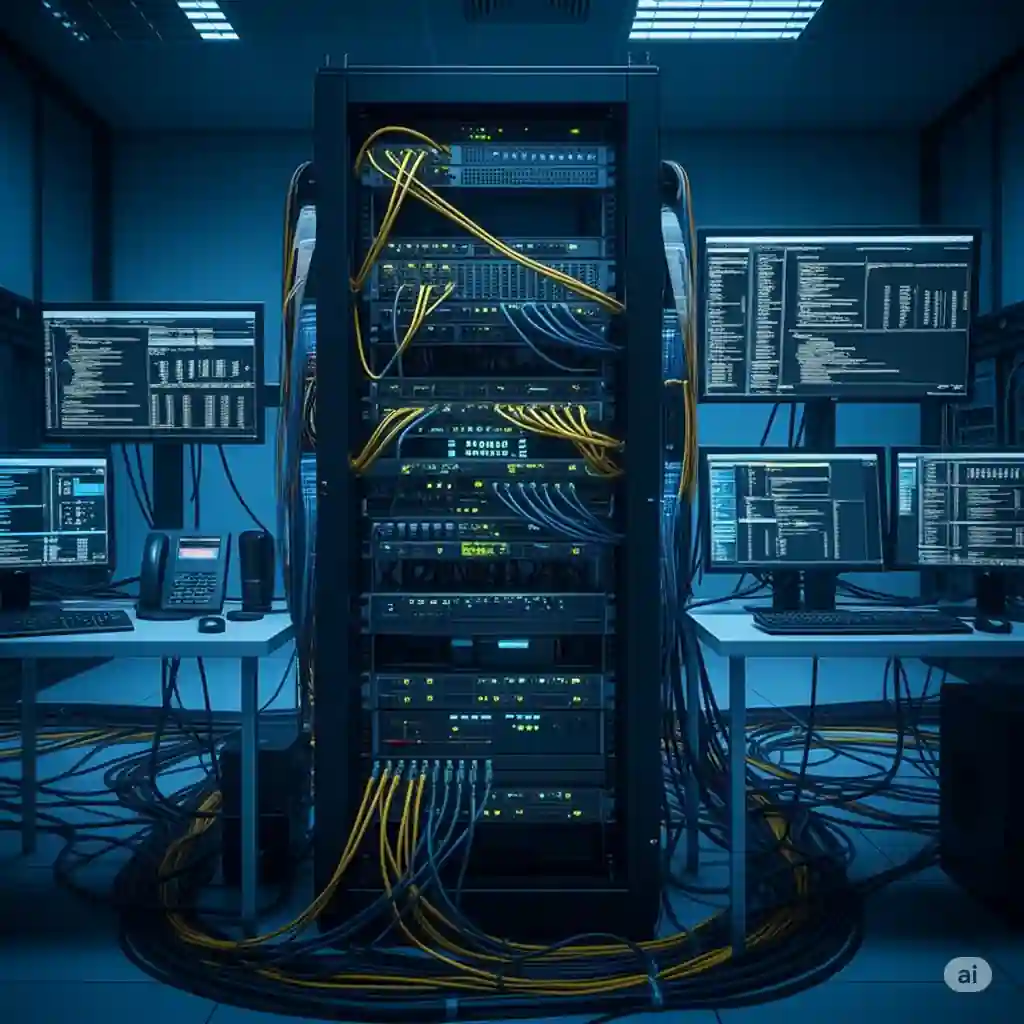Introduction: Next Generation Construction
imagine: a construction site in 2030. No screams of foremen, mountains of paper drawings and chaotic truck traffic. Instead, it’s a quiet digital ballet where drones scan every inch, neural networks warn accidents before they occur, and concrete “informs” sensors when it’s ready to load.
Does it sound like fiction? Not anymore.
The construction industry has traditionally been considered conservative, slow to innovate. But today this is rapidly changing. Billions of investments are being made in technologies that will transform construction from a hammer-and-nail industry into the high-tech industry of the future. And artificial intelligence has become the catalyst for these changes.
Artificial intelligence doesn’t just “help” — it rewrites the rules of the construction game. And modern megacities with their ambitious projects can become the main characters of this revolution.
Fundamental importance: Why AI in construction is not just a fashion trend
Safety: Saving lives every day
Construction workers die on construction sites every year. It’s shocking, especially if you imagine that behind every statistical unit there is a human life, family, hopes and dreams. In regions of active construction, where large-scale projects are growing like mushrooms, this problem is particularly acute.
The human factor, fatigue, haste, carelessness — all this continues to lead to tragedies.
However, artificial intelligence-based systems can dramatically change the situation.:
- Continuous 24/7 monitoring, not subject to fatigue or inattention
- Instant reaction to potentially dangerous situations
- Analyzing patterns and predicting possible occurrences before they occur
- Automatic installation of equipment in case of risk to people
According to the International Labor Organization, the introduction of AI safety systems can reduce the number of fatal accidents on construction sites by up to 70% over the next 10 years. That’s thousands of lives saved.
Cost-effectiveness: Mistakes that cost billions
The construction industry is notorious for its cost overruns and deadlines. According to a McKinsey study, more than 80% of large construction projects exceed the budget by an average of 20-30%, and deadlines by 20-40%. Every mistake in design or execution can lead to catastrophic consequences both for the budget and for the safety of structures.
AI offers a multi-layered approach to solving this problem.:
- Preliminary modeling and simulation of all stages of construction with identification of potential problems
- Optimization of logistics of building materials and machinery
- Forecasting delays and suggesting alternative implementation paths
- Real-time quality control with immediate elimination of deviations
The economic impact of the introduction of AI in construction is estimated by experts from the Boston Consulting Group at $1.2-1.7 trillion globally by 2035. This is equivalent to about 15-20% of the global construction industry.
Eco-friendliness: Green construction is getting smarter
The construction and operation of buildings are responsible for about 38-40% of global co₂ emissions (United Nations Environment Programme, UNEP 2023). In the era of the climate crisis, this fact cannot be ignored. Smart AI-based systems can radically reduce the negative impact on the environment.:
- Reduction of construction waste by 30-40% due to accurate calculation of required materials (McKinsey Global Institute, 2023)
- Optimization of energy consumption at all stages of construction (IEA Global Status Report 2023)
- Minimization of transport emissions through rational logistics (Environmental Science & Technology, 2022)
- Designing buildings based on their full life cycle, including the possibility of recycling materials (Ellen MacArthur Foundation, 2024)
A study by the World Economic Forum (WEF Report “Buildings of Tomorrow”, 2023) shows that the introduction of AI in construction can reduce the carbon footprint of the industry by 21% by 2035, which is equivalent to the annual emissions of the whole of India.
Speed: Time is money that no one wants to lose
The duration of construction directly affects its profitability. Every day of delay is not only a direct loss from downtime of equipment and labor, but also a lost benefit from the use of the facility.
Automation of control and decision-making using AI allows:
- Accelerate the construction process by an average of 20-30%
- Minimize downtime through predictive maintenance
- Optimize the sequence of work and the movement of resources
- Reduce design time by using generative algorithms
For example, one Chinese company, using advanced AI planning systems and modular construction, built a 57- storey skyscraper in just 19 days, a result that would not have been possible with a traditional approach.
Invisible Observer: how artificial intelligence prevents accidents at a construction site
Modern computer vision systems combined with AI create an unprecedented level of control over the construction site. Imagine a camera that doesn’t just take pictures, but understands what’s going on.:
- A worker without insurance entered the “red zone”? → The system locks the faucet and sends a signal to the foreman.
- Is the faucet overloaded? → Automatic stop before checking.
- Is someone stealing rebar at night? = The AI detects movement and calls security.
- A worker at height without a helmet or insurance? → Immediate notification of supervisors.
- Dangerous approach of technology to people? → Automatic deceleration or stop.
Object and action recognition technology has come a long way in recent years. Modern neural networks are able to identify potentially dangerous situations with an accuracy of more than 99.5%, which exceeds the capabilities of human surveillance.
The real case: At the construction site of a 320-meter skyscraper in Dubai, an AI monitoring system reduced injuries by 40% during the first year of use. The system automatically identified non-compliance with safety requirements and alerted the construction site management in real time.
Developers are already testing a robot equipped with 360° cameras and laser scanning systems that bypasses construction sites and identifies dangerous areas before people enter there. The robot is able to climb stairs, navigate uneven surfaces, and even open doors, providing full monitoring of the area.
Digital Foreman: An AI that predicts the future
Predictive analytics is becoming one of the most valuable applications of AI in construction. By processing huge amounts of data, algorithms identify patterns and trends that are inaccessible to human perception.

The AI analyzes:
- Weather and climate: “There’s a storm tomorrow — reschedule work on the roof for next week, otherwise there will be a 3-day delay. Reallocate the crews for internal work in Sector B.”
- Technical wear and tear: “This concrete pump shows abnormal vibration patterns — the probability of failure is 78% within the next 72 hours. Preventive maintenance is recommended tonight.”
- Human factor: “Team No. 3 is working 17% slower than the standard pace for the third day in a row. The analysis shows elevated temperatures in their work area and insufficient ventilation.”
- Possible conflicts in the project: “A potential discrepancy has been discovered between the ventilation and lighting systems on the 12th floor. An adjustment is suggested before installation begins.”
- Market trends: “Aluminum structures are forecast to be in short supply in the next quarter due to trade restrictions. It is recommended to purchase for future use at a discount of 12% from supplier A.”
Fact: In a megaproject for the construction of a high-speed railway in the UK, an algorithm predicted a crane accident 2 hours before a potential collapse by analyzing the micro-vibrations of the structure and comparing them with historical data on similar incidents. Timely evacuation of personnel and strengthening of the structure made it possible to avoid a disaster.
A construction site without people? Robots + AI = fiction that has become reality
Automation of physical labor in construction is developing in several directions simultaneously:
Autonomous heavy machinery:
- Autonomous bulldozers level the sites with an accuracy of 5 mm, using a combination of satellite navigation, lidar and AI for soil analysis.
- Self-driving excavators capable of independently digging trenches and ditches, bypassing underground utilities and obstacles.
- Autonomous road rollers that work in coordination with pavers to achieve perfect pavement quality.
Drones and construction robots:
- Construction drones that weld metal structures of complex geometry with micron precision overnight (projects in the Netherlands, including the famous 3D-printed canal bridge in Amsterdam).
- Bricklaying robots that lay up to 3,000 bricks per day (6 times more than a human) with perfect geometry and minimal mortar consumption.
- Finishing robots capable of plastering and painting walls with impeccable quality beyond the reach of humans.
3D printing in construction:
- Companies in the United States have built a residential area of 100 houses in a third of the usual time using giant 3D printers powered by AI algorithms.
- A project in the UAE demonstrated the possibility of 3D printing a two-storey administrative building with an area of 640 square meters. m in 2 weeks.
- A Chinese technology company has built a six-storey office building using 3D printing, reducing construction waste by 60% and labor costs by 80%.
Exoskeletons and amplifiers for workers:
- Industrial exoskeletons increase the strength of workers by 20 times, allowing one person to lift 90-kilogram beams without strain and risk of injury.
- “Smart gloves” with built-in scanners and sensors that monitor the correctness of the worker’s actions and warn of possible errors.
- Augmented reality helmets that project construction drawings directly onto real structures and provide step-by-step instructions for complex installation work.
It is important to note that the purpose of these technologies is not to replace people, but to create “enhanced builders” where human intelligence and experience are complemented by technological capabilities.
Digital twins: virtual copies of buildings
Digital twin technology is one of the most revolutionary applications of AI in construction. Unlike traditional BIM modeling, a digital twin is a dynamic model that is constantly updated and “lives” in parallel with a real object throughout its life cycle.
The key advantages of digital twins:
- The building is completely “built” in numbers down to the first kopeck of the foundation, which makes it possible to identify and eliminate up to 92% of potential design problems.
- All communications, loads, and heating are calculated in advance, taking into account the mutual influence of the systems.
- Warning about problems: “Leakage is possible in this place after 5 years due to increased corrosion activity” or “The load on this beam will exceed the permissible in case of an earthquake with a magnitude of more than 5 points.”
- Optimization of resource consumption in real time based on the analysis of building usage patterns.
- Modeling of various scenarios of operation and reconstruction.
Example: Singapore has created a digital twin of the entire city, which has optimized traffic flows, energy consumption and the construction of new facilities, reducing the carbon footprint of the metropolis by 30%. Each new building is checked for compatibility with the citywide model at the design stage.
Innovative companies are using digital twins for smart buildings, where AI is constantly analyzing data from thousands of sensors, optimizing the microclimate, lighting and safety, taking into account the weather, time of day and the number of people in different areas of the building.
Smart materials controlled by AI
A revolution in construction is impossible without the transformation of the building materials themselves. Modern research in the field of materials science combined with AI control creates truly fantastic opportunities.:
Self-healing materials:
- Concrete with capsules of bacteria Bacillus pseudofirmus or Sporosarcina pasteurii, which are activated when cracks form, secrete calcite and “heal” damage.
- Polymer coatings with microcapsules of monomers that polymerize when the integrity of the material is compromised.
- Metal alloys with “shape memory” that return to their original configuration when heated.
Energy generating structures:
- Photovoltaic facades that turn buildings into power plants (a modern office building in Amsterdam generates 102% more energy than it consumes).
- Pedestrian paths that generate electricity from footsteps.
- Building blocks that accumulate solar energy during the day and release it as heat at night.
Heavy-duty nanocomposites:
- Graphene reinforcing elements are 200 times stronger than steel with a lower weight, which makes it possible to create ultrathin load-bearing structures.
- Carbon nanotubes that increase the strength of concrete by 50% while reducing its mass by 30%.
- Aerogel is an ultralight thermal insulator that prevents heat loss 2-3 times more efficiently than traditional materials.
Smart sensor materials:
- Concrete with integrated fiber-optic sensors that report microcracks and load changes.
- “Smart cement” with the addition of carbon nanotubes, which changes the electrical resistance during deformation, which allows you to monitor the condition of the structure in real time.
- Thermochromic coatings that change color depending on temperature, visualizing the heat loss of a building.
Innovation: The Swiss Federal Institute of Technology (ETH Zurich) has developed a “smart cement” with built-in sensors that automatically reports its humidity, temperature and load readiness. The AI analyzes this data and adjusts the holding time and the curing process, which makes it possible to achieve the ideal quality of concrete structures.
Overcoming Barriers: Challenges on the way to smart construction
Despite the obvious advantages, the introduction of AI in construction faces a number of serious challenges.:
Investment threshold
The introduction of AI requires significant initial investments, from equipping construction sites with sensors and cameras to staff training and integrating new systems into existing business processes. McKinsey estimates that the complete digitalization of an average construction project can cost from 3% to 5% of its budget.
However, the economic effect is usually not long in coming:
- Reduction of insurance payments by 30-40%
- Reducing error correction costs by 45-60%
- Reduction of construction time by 15-25%
- Optimize the use of materials and resources by 20-30%
As a result, according to the Boston Consulting Group, the payback period for investments in AI for construction is on average 2-3 years, which makes these investments economically attractive even for conservative investors.
Cybersecurity: new risks of smart construction
Digitalization of any industry inevitably leads to the emergence of new vulnerabilities. These risks are particularly critical for construction due to the potential physical consequences of digital attacks.
Imagine scenarios:
- Hacker attack on construction crane control system
- Manipulation of structural strength data
- Sabotage of security systems
- Theft of confidential project data
To minimize these risks, it is necessary:
- Multilevel protection systems with physical separation of critical circuits
- Continuous cybersecurity audit at all stages of the project
- Training staff to recognize phishing attacks
- Redundant analog monitoring systems for critical parameters
Staff adaptation: the human factor
The construction industry is traditionally conservative, and the average age of skilled workers in many countries exceeds 45 years. Resistance to change can be a major obstacle to the adoption of AI.
A Deloitte study shows that up to 60% of failures in the digital transformation of construction companies are related to the human factor, rather than technological problems.
To overcome this barrier, it is necessary:
- Retraining and digital literacy programs
- Visual demonstration of the benefits of new technologies for security and productivity
- Gradual introduction of innovations with active involvement of staff
- Financial incentives for the development of new technologies
Ethical issues and privacy
Total monitoring of the construction site raises issues of privacy and digital control. No one wants to feel under the constant supervision of algorithms that evaluate every move.
To achieve a balance between efficiency and respect for privacy,:
- Clear rules for data collection and use
- Transparency of performance evaluation algorithms
- The ability to enable personal monitoring in certain areas
- Participation of workers’ representatives in the development of AI use policies
Horizons of the future: Construction in 10 years
Analyzing current trends and the speed of technology development, it is possible to predict what the construction site will look like by 2035.:
Full automation of routine tasks
Human physical labor will focus on complex, non-standard operations that require adaptive thinking and fine motor skills. All routine, dangerous, and monotonous tasks will be performed by AI-controlled robotic systems.:
- Excavation work
- Construction of standard structures
- Transportation of materials
- Standard type finishing works
A person will become an operator and controller rather than the direct executor of most construction operations.
AI architects and generative design
Even today, generative design algorithms are able to create optimal designs that are inaccessible to traditional engineering thinking. By 2035, this technology will reach maturity.:
- Creating complete architectural designs in minutes instead of months
- Optimizing designs for dozens of parameters at the same time
- Automatic adaptation of projects to local regulations and conditions
- Personalized solutions for each building, taking into account the specifics of the area and needs
AI architects will work in tandem with humans, offering solutions and justifying their choice, leaving the final decision and creative direction to humans.
Smart cities with self-diagnosis
Buildings will cease to be passive structures and will turn into active elements of the urban ecosystem, continuously communicating with each other and with a centralized management system.:
- Automatic detection of structural damage and initiation of repairs
- Adaptive energy consumption depending on the weather and workload
- Dynamic redistribution of infrastructure load
- Coordination between buildings to optimize traffic flows and power grids
According to UN forecasts, by 2035, more than 250 cities around the world will use integrated AI systems to coordinate the construction and functioning of urban infrastructure.
Zero injuries and zero emissions
Thanks to predictive safety systems and automation of hazardous work, it is quite possible to achieve zero injuries on modern construction sites by 2035.
At the same time, the development of a cyclical economy in construction will allow the industry to achieve carbon neutrality.:
- Complete disposal and recycling of construction waste
- Use of renewable or CO₂ trapping materials
- Energy efficient construction with minimal carbon footprint
- Buildings as carbon sinks thanks to special materials and living facades
Conclusion: The construction revolution has already begun
Artificial intelligence doesn’t just change certain aspects of construction — it transforms the very essence of this ancient human activity. From design to operation, from the choice of materials to the organization of work, AI is becoming an integral component of the modern construction process.
Do you still think that AI is “about the Internet”?
The next skyscraper, transportation hub, or school in your city will already be built using the technologies described in this article.
Disclaimer: This article is for informational purposes only and does not contain advertisements for any goods or services. All the mentioned technologies and research are provided for educational purposes. The implementation of the described technologies should be carried out in accordance with the current legislation of the Republic of Kazakhstan.




